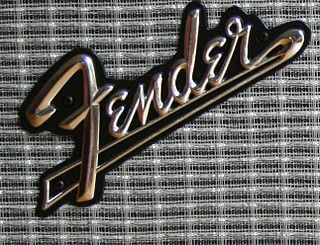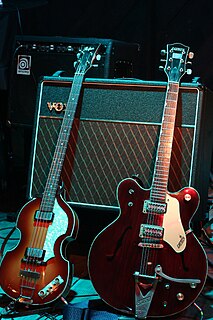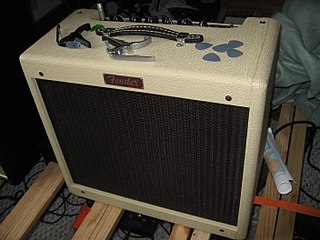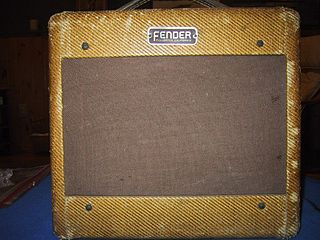This article has multiple issues. Please help improve it or discuss these issues on the talk page . (Learn how and when to remove these template messages)
|

The Epiphone Valve Junior is a small 5 watt class A electric guitar amplifier.
This article has multiple issues. Please help improve it or discuss these issues on the talk page . (Learn how and when to remove these template messages)
|

The Epiphone Valve Junior is a small 5 watt class A electric guitar amplifier.
The Epiphone Valve Jr. version 1 combo was released in 2005 as a part of Epiphone's line of amplifiers. In January 2006 a head version was released and also a version 2 combo. In June 2007 an updated head version and a version 3 combo were released. The first Epiphone Valve Juniors (version 1) were only combo amplifiers and received only a fair reception, due to such problems as buzzing and hum caused by the AC filament voltage. Epiphone then released a head version, correcting these issues and changed the AC filament voltage to DC voltage. Version 2 combos also featured these modifications. The version 1 and version 2 combos feature an 8 in (200 mm)4 Ω ceramic speaker.
Epiphone released Combo version 3 and a newer version of the head with higher retail prices and feature a variety of tube brands based on availability including Electro-Harmonix, JJ, and Sovtek. The newer versions of the head and version 3 combos feature updated transformers with 4, 8, and 16 Ω outputs and the version 3 combos feature an 8 in (200 mm)16 Ω Eminence Lady Luck speaker. In 2007, Epiphone released a speaker cabinet that can be used with the Epiphone Valve Junior, featuring a 12 in (300 mm)16 Ω Eminence Lady Luck speaker rated at 70 W RMS.
As of summer 2012, these amplifiers appear to have been dropped from the line. The amplifiers page no longer exists on the Epiphone website.
The Epiphone Valve Junior has become very popular to modify because of its basic design. There are many websites, kits, and forums dedicated to this purpose, including the Epiphone official amps and accessories forum. Some sites offer kits to match the gain characteristics of Marshall, Fender and Vox amplifiers. These kits often do not include a bridge rectifier to convert the version 1 AC filament supply voltage to DC, instead they suggest twisting the AC leads together to cancel the generated electromagnetic fields, a technique used in twisted-pair Ethernet cable to eliminate crosstalk.
A somewhat limited edition of the Valve Junior head was produced by Epiphone, dubbed the Valve Junior Hot Rod. It was released as a response to the extensive number of modifications that were being applied to the regular Valve Junior. The circuitry was altered to include a second 12AX7 preamp tube, a gain control, and a spring reverb in addition to the single volume control, as well as a standby switch to preserve tube life. Thanks to a dual function jack on the amp's rear panel, the Hot Rod can also be used as a standalone reverb unit to be used in conjunction with another amplifier's input or effects loop. In this function, the gain knob becomes the unit's dwell control, the volume knob retains its level function, and the reverb knob becomes the mixture control. When used as a reverb unit, the Hot Rod does not need to have a speaker connected to its output jacks because an internal "dummy load" activates automatically when the Reverb output jack is used.
The first 4 digits of the serial number are the date code MMYY (MM = month, YY = year). Version 2 Valve Juniors have date codes starting at "0106" January 2006 up to June 2007 when version 3 was released.

Vox is a musical equipment manufacturer founded in 1957 by Thomas Walter Jennings in Dartford, Kent, England. The company is most famous for making the Vox AC30 guitar amplifier, used by The Beatles, The Rolling Stones, The Kinks, The Yardbirds, Queen, Dire Straits, U2, and Radiohead; the Vox Continental electric organ, the Vox wah-wah pedal used by Jimi Hendrix, and a series of innovative electric guitars and bass guitars. Since 1992, Vox has been owned by the Japanese electronics firm Korg.

A guitar amplifier is an electronic device or system that strengthens the weak electrical signal from a pickup on an electric guitar, bass guitar, or acoustic guitar so that it can produce sound through one or more loudspeakers, which are typically housed in a wooden cabinet. A guitar amplifier may be a standalone wood or metal cabinet that contains only the power amplifier circuits, requiring the use of a separate speaker cabinet–or it may be a "combo" amplifier, which contains both the amplifier and one or more speakers in a wooden cabinet. There is a wide range of sizes and power ratings for guitar amplifiers, from small, lightweight "practice amplifiers" with a single 6" speaker and a 10 watt amp to heavy combo amps with four 10” or four 12" speakers and a powerful 100 watt amplifier, which are loud enough to use in a nightclub or bar performance.
Orange Music Electronic Company is an English amplifier manufacturing company. The amplifiers have a distinctive sound and bright orange Tolex-like covering their heads and speaker cabinets.

Marshall Amplification is a British company that designs and manufactures music amplifiers, speaker cabinets, brands personal headphones and earphones, a record label and, having acquired Natal Drums, drums and bongos. It was founded by drum shop owner and drummer Jim Marshall, and is now based in Bletchley, Milton Keynes, Buckinghamshire.

Fender amplifiers are a series of electric instrument amplifiers renowned by musicians worldwide. The Fender Musical Instruments Corporation has continuously manufactured guitar amplifiers since their foundation, Leo Fender began building guitar amplifiers before he started manufacturing electric guitars. The first of these were the K&F models, produced between 1945 and 1946. Fender amplifiers would become favourites of many famous guitarists such as Stevie Ray Vaughan, Jimi Hendrix and Eric Clapton, helping them pioneer their sounds.

The Vox AC30 is a guitar amplifier manufactured by Vox. It was introduced in 1958 to meet the growing demand for louder amplifiers. Characterised by its "jangly" high-end sound it has become widely recognized by British musicians and others.

A bass amplifier or "bass amp" is a musical instrument electronic device that uses electrical power to make lower-pitched instruments such as the bass guitar or double bass loud enough to be heard by the performers and audience. Bass amps typically consist of a preamplifier, tone controls, a power amplifier and one or more loudspeakers ("drivers") in a cabinet.
The Fender Prosonic guitar amplifier was produced by Fender Musical Instruments from 1996 to 2002. Available in head and combo versions, the Prosonic featured several departures in design from traditional Fender amplifiers such as the Bassman, Twin Reverb, and Deluxe Reverb. Designed by Bruce Zinky as a project for the Fender Custom Shop, the amplifier later had a non-Custom Shop production run at the Fender facilities in Corona, California. It was initially priced to compete with buyers in the so-called boutique amplifier market who were seeking more distortion than any previous Fender had ever offered. It is believed that high list prices, and deviations from established Fender amplifier designs, swayed many buyers away from the Prosonic. It developed a cult following among serious guitarists, aided by the rise of musician-centric Internet communities.

The Fender Twin and Twin Reverb are guitar amplifiers made by Fender Musical Instruments Corporation. The Twin was introduced in 1952, two years before Fender began selling Stratocaster electric guitars. The amps are known for their characteristically clean tone.

T-Rex ApS is a manufacturer of handmade electric guitar effects pedals.

The Fender Hot Rod Deluxe is a guitar amplifier manufactured and sold by the Fender Musical Instruments Corporation. It was introduced in 1996 as part of the "Hot Rod" line of guitar amplifiers and has been in continuous production since. The Hot Rod Deluxe is a modified version of the Fender Blues Deluxe from the earlier Blues line of amplifiers, and has a higher level of gain in its preamplification signal. This model, along with the Hot Rod Deville, were originally designated as F.A.T. amplifiers but this moniker was dropped in 2002 when production of this series of amps was moved from Corona, CA to Fender's Baja-Ensenada, Mexico manufacturing facility.

The Blues Junior is a tube guitar amplifier introduced in 1990 by the Fender Musical Instrument Corporation. It is aimed at achieving the warm, tube-driven tone common in many styles of American blues and blues rock dating back to the 1950s, while remaining both portable and affordable. Fender frequently releases limited editions of the Blues Junior. All have the same electronic components and specifications but have cosmetic changes and often a different speaker, at varying prices.

The Fender Hot Rod DeVille is a combo tube guitar amplifier manufactured and sold by Fender. It was introduced in 1996 as part of Fender's Hot Rod line of amplifiers, and since then has been in continuous production. The Hot Rod DeVille is a modified version of the earlier Fender Blues DeVille from the Blues amplifier line, and has a higher level of gain in its preamplification signal. The DeVille incorporates a 60 watt amplifier, and is available in two different models: a 212, which includes a pair of Celestion A-Type 12" speakers, and the 410, which includes four 10" speakers. The DeVille is the sister amplifier of the Fender Hot Rod Deluxe.

The Fender Champ was a guitar amplifier made by Fender. It was introduced in 1948 and discontinued in 1982. An updated version was introduced in 2006 as part of the "Vintage Modified" line.

The Fender Princeton was a guitar amplifier made by Fender. It was introduced in 1947 and discontinued in 1979. After Fender introduced the Champ Amp in 1948, the Princeton occupied the next to the bottom spot in the Fender line. Fender Princetons from the early models into the 1970s models are highly valued particularly as recording amplifiers.
The Ampeg SVT is a bass guitar amplifier designed by Bill Hughes and Roger Cox for Ampeg and introduced in 1969. The SVT is a stand-alone amplifier or "head" as opposed to a "combo" unit comprising amp and speaker(s) in one cabinet, and was capable of 300 watts output at a time when most amplifiers could not exceed 100 watts output, making the SVT an important amp for bands playing music festivals and other large venues. The SVT has been through many design changes over the years but is still in production today. While the SVT could be used with any 300 watt, 2- or 4-ohm cabinet combination, Ampeg recommended that it be used with a pair of sealed 8x10" speaker enclosures because one cabinet could not handle the power of the SVT. It wasn't until 1980 that the speakers in the enclosures were updated to a power handling rating of 350 watts, allowing a player to use an SVT head with only one cabinet!

The Mesa Boogie Mark Series is a series of guitar amplifier made by Mesa Engineering. Originally just referred to as "Boogies," the product line took on the moniker "Mark Series" as newer revisions were put into production. The Mark Series amplifier was Mesa's flagship product until the introduction of the Rectifier series, and the amplifiers are collectable.
The Fender Deluxe guitar amplifier is a range of non-reverb guitar amplifiers produced by Fender. The amplifiers were originally produced from early 1948 to 1966 and reissues are in current production. Its predecessor was the Fender Model 26 "Woodie" produced from 1946 to 1948.
The Fender Pro was an instrument amplifier manufactured by Fender Electric Instruments from 1946 to 1965. It was characterized by its dual 6L6-family power tubes and single 15" speaker, with output power increasing from 18 watts up to 40 watts over its production run. The Pro was replaced in the Fender lineup by its offspring the Pro Reverb.